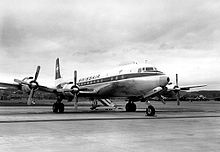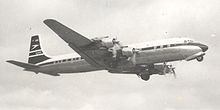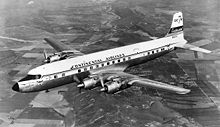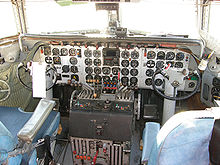- Douglas DC-7
-
DC-7 Butler Aircraft Services' DC-7, Tanker 66 Role Airliner/transport aircraft Manufacturer Douglas Aircraft Company First flight May 1953 Primary user American Airlines Produced 1953-1958 Number built 338 Developed from Douglas DC-6 The Douglas DC-7 is an American transport aircraft built by the Douglas Aircraft Company from 1953 to 1958. It was the last major piston engine powered transport made by Douglas, coming just a few years before the advent of jet aircraft such as the Boeing 707 and Douglas DC-8.
Contents
Design and development
Pan American World Airways originally requested the DC-7 in 1945 as a civilian version of the Douglas C-74 Globemaster military transport. It canceled its order shortly afterward; that DC-7 is unrelated to the later airliner.
American Airlines revived the designation when it requested an aircraft that could fly the USA coast to coast non-stop in about eight hours. Robert Rummel (at the time head of engineering at TWA) has stated that pilot union rules limiting flying time to eight hours per day influenced American's request to Douglas.[1] Douglas was reluctant to build the aircraft until American Airlines president C. R. Smith placed a firm order for 25 at a price of $40 million, thus covering Douglas' development costs.
The prototype flew in May 1953 and American received its first DC-7 in November, inaugurating the first non-stop east-coast-to-west-coast service in the country (optimistically scheduled just under the eight-hour limit for one crew) and forcing rival TWA to offer a similar service with its Super Constellations. Both aircraft frequently experienced in-flight engine failures, causing many flights to be diverted.
The original DC-7 was followed by the DC-7B, identical except for slightly greater power and, on some DC-7Bs (Pan Am and South African Airways), fuel tanks added in longer engine nacelles. South African Airways used this variant on their Johannesburg to London route.
Operational history
The early DC-7s were only sold to U.S. carriers. European carriers could not take advantage of the small range increase in the early DC-7, so Douglas released an extended-range variant, the DC-7C (Seven Seas) in 1956. Two 5 ft (1.5 m) wing-root inserts added fuel capacity, reduced interference drag, and made the cabin quieter by moving the engines further outboard; all DC-7C's had the nacelle fuel tanks previously seen on Pan American's and South African's DC-7Bs. The fuselage, which had been extended over the DC-6B's with a 40 in (100 cm) plug behind the wing for the DC-7 and -7B, was lengthened with a similar plug ahead of the wing to give the DC-7C a total length of 112 ft 3 in (34.21 m).
Since the late 1940s Pan Am and other airlines had scheduled a few nonstop flights New York to Europe, but westward nonstops against the wind were rarely possible with an economic payload. The 1049G and DC-7B that appeared in 1955 could make the trip if the headwinds weren't bad, but in summer 1956 Pan Am's DC-7C (a long-range model dubbed the "Seven Seas") finally started making the westward trip fairly reliably. BOAC was forced to respond by purchasing DC-7Cs rather than wait on the delivery of the Bristol Britannia. The DC-7C found its way into several other overseas airlines' fleets, including SAS, which used them for cross-polar service to North America and Asia. The DC-7C sold better than its rival, the Lockheed L-1649A Starliner, which entered service a year later,[2] but sales were cut short by the arrival of Boeing 707 and DC-8 jet aircraft in 1958-60.
Starting in 1959, Douglas began converting DC-7 and DC-7C aircraft into DC-7F freighters, which extended the life of the aircraft past its viability as a passenger transport.
The predecessor DC-6, especially the DC-6B, had established, for its time, a reputation for straightforward engineering and reliability. Pratt & Whitney, manufacturer of the the DC-6's Double Wasp engines, did not offer an effective larger engine apart from the Wasp Major, which had a reputation of poor reliability.[citation needed] Therefore Douglas turned to Wright Aeronautical for a more powerful engine. The Duplex-Cyclone had reliability issues of its own, and this affected the DC-7's service record and usage. Carriers which had both DC-6s and DC-7s in their fleets usually replaced the newer DC-7s first once jets started to arrive. Some airlines had to scrap their DC-7s after little more than five years of service, whereas the vast majority of DC-6s lasted longer and then sold more readily on the secondhand market.
Variants
- DC-7
- DC-7B
- DC-7C ("Seven Seas")
- DC-7D (Unbuilt variant.)
Operators
Main article: Douglas DC-7 operators DC-7 in Delta Air Lines livery
DC-7 in Delta Air Lines livery
Airlines
Historical operators of the DC-7 include Aeromexico, Alitalia, American Airlines, BOAC, Braniff Airways, Caledonian Airways, Delta Air Lines, Eastern Air Lines, Japan Airlines, KLM, National Airlines, Northwest Orient, Panair do Brasil, Pan American World Airways, Sabena, SAS, South African Airways, Swissair, THY, TAI, and United Airlines.
In 2010, 17 DC-7s remained on the U.S. civil aviation registry,[3] used mainly for cargo and as airtankers. Due to its engine problems, the DC-7 has not had the same longevity as the DC-6, which is still used by a number of commercial operators.[citation needed]
Military Operators
Orders and production
Airline DC-7 DC-7B DC-7C Notes Alitalia 0 0 6 American Airlines 34 24 0 British Overseas Airways Corporation 0 0 10 Braniff Airways 0 0 7 Continental Air Lines 0 5 0 Delta Air Lines 10 10 0 Eastern Air Lines 0 49 0 Japan Air Lines 0 0 4 KLM 0 0 15 Mexicana 0 0 4 National Airlines 4 4 0 Northwest Orient Airlines 0 0 14 Pan American-Grace Airways 0 6 0 Pan American World Airways 0 6 27 Panair do Brasil 0 0 2 Sabena 0 0 10 3 were leased Scandinavian Airlines System 0 0 14 South African Airways 0 4 0 Swissair 0 0 5 Transports Aériens Intercontinentaux 0 0 4 United Air Lines 57 0 0 Douglas Aircraft 0 2 0 Written off before delivery 0 1 0 DC-7B prototype delivered to Delta Air Lines 0 0 1 DC-7C prototype delivered to Panair do Brasil Totals 105 111 122 Total built 338 Accidents and incidents
- June 30, 1956: A United Airlines DC-7 and a TWA L-1049 Super Constellation collided over the Grand Canyon in Arizona, resulting in the deaths of 128 people on both aircraft.
- January 31, 1957: A DC-7 crashed into a school yard in the Pacoima area of Los Angeles, California, following a midair collision with a two-man Northrop F-89J Scorpion jet fighter, resulting in the deaths of the four crewmembers aboard the DC-7, the pilot of the Scorpion jet, and three students on the ground.[4][5]
- March 25, 1958: A Braniff Airlines DC-7c crashed shortly after takoff from Miami while attempting to return after an engine caught fire. Nine passengers out of 24 people aboard died in the accident.
- April 21, 1958: A United Airlines DC-7 en route from Los Angeles to Denver collided with a USAF F-100 fighter near Las Vegas. Both aircraft crashed out of control resulting in the deaths of 49 people.
- May 18, 1958: A Sabena DC-7 crashed near Casablanca Airport during an emergency landing. All nine crewmembers and 52 of the 56 passengers were killed.
- September 24, 1959: A Transports Aériens Intercontinentaux (TAI) DC-7 crashed at Bordeaux airport with the loss of 54 lives. After takeoff, the aircraft failed to gain altitude and collided with trees three km from the start of the takeoff.
- November 16, 1959: National Airlines Flight 967 on a flight from Tampa, Florida to New Orleans crashed into the Gulf of Mexico. All 42 occupants perished. Although sabotage was suspected, no definite reason for this crash was ever determined.[6]
- February 26, 1960: An Alitalia DC-7C crashed at Shannon Airport, Ireland, shortly after takeoff with 34 fatalities out of 52 passengers and crew. No cause was ever determined for this accident.
- November 1, 1961: A Panair do Brasil DC-7C flying from Sal to Recife crashed into a hill about 2.7 km short of the runway at Recife. Forty-five passengers and crew out of the 88 persons aboard lost their lives. The accident was attributed to pilot error.[7]
- March 6, 1962: Caledonian Airways Flight 153 crashed into a swamp shortly after takeoff from Douala International Airport, killing all 111 people on board. It is the worst single-aircraft accident of a DC-7.
- November 30, 1962: An Eastern Airlines DC-7B on a flight from Charlotte, North Carolina, to New York-Idlewild crashed after a missed approach due to fog. Improper crew procedures were blamed on this accident which cost 25 lives out of 51 passengers and crew.
- June 3, 1963: Northwest Orient Airlines Flight 293, a Military Air Transport Service from McChord Air Force Base in Washington state to Elmendorf Air Force Base in Alaska crashed into the Pacific near Annette Island, Alaska, with the loss of all 101 people aboard. The cause of the crash remains unknown.
- February 8, 1965: Eastern Air Lines Flight 663 crashed a few minutes after takeoff from John F. Kennedy Airport in New York after taking sudden evasive action to avoid a possible collision with another airliner. All 84 passengers and crew died.
- December 31, 1972: Major League baseball player Roberto Clemente, traveling to Nicaragua for an earthquake relief effort, died after the DC-7 aircraft he was aboard crashed after takeoff off the coast of San Juan, Puerto Rico. All five people on the plane were killed in the crash.[8]
- June 21, 1973: About 6 minutes after take-off from Miami International Airport, a Skyways International DC-7C crashed, apparently caused by an onboard fire and/or severe turbulence. 3 crew members, the sole occupants, were killed.
- September 14, 1979: A Butler Aircraft Inc. DC-7 transporting company employees to Medford, Oregon crashed on the crest of Surveyor Mtn near Klamath Falls, Oregon. The cause of the accident which claimed the 12 occupants aboard, was attributed to the crew's decision to undertake a night flight at low altitude.
Specifications
DC-7 Cockpit - From the display at the National Air and Space Museum in Washington, DC
DC-7
Data from the American Museum of Aviation[9]
General characteristics
- Crew: 2 Pilots 1 Flight Engineer & 2 Flight Attendants
- Capacity: 64 to 95 Passengers
- Length: 108 ft 11 in (33 m)
- Wingspan: 117 ft 6 in (35 m)
- Height: 28 ft 7 in (8 m)
- Empty weight: 58,150 lbs (26,376 kg)
- Max takeoff weight: 114,600 to 122,000 lbs (51,981 to 55,338 kg)
- Powerplant: 4 × Wright R-3350-30W radial piston engines, 3,250 hp (2,423 kW) each
Performance
- Maximum speed: 405 mph (653 km/h)
- Cruise speed: 359 mph (570 km/h)
- Stall speed: 97 mph (156 km/h)
- Range: 5,164 mi w/ max fuel & 3,565 mi w/ max payload (8,310 km w/ max fuel & 5,737 km w/ max payload)
- Service ceiling: 28,400 ft (8,656 m)
DC-7C
Data from the American Museum of Aviation[10]
General characteristics
- Crew: 2 Pilots 1 Flight Engineer & 4 Flight attendants
- Capacity: 102 Passengers
- Length: 112 ft 3 in (34 m 7 cm)
- Wingspan: 127 ft 6 in (38 m 15 cm)
- Height: 31 ft 10 in (9 m 25 cm)
- Empty weight: 72,763 lbs (33,005 kg)
- Max takeoff weight: 143,000 lbs (64,863 kg)
- Powerplant: 4 × Wright R-3350-988TC18EA1-2 radial piston engines, 3400 hp (2,535 kW) each
Performance
- Maximum speed: 406 mph (653 km/h)
- Cruise speed: 359 mph (578 km/h)
- Stall speed: 97 mph (156 km/h)
- Range: 5,600 mi (9,012 km)
- Service ceiling: 28,400 ft (8,656 m)
See also
- Related development
- Aircraft of comparable role, configuration and era
- Lockheed Constellation
- Lockheed L-049 Constellation
- Lockheed L-1049 Super Constellation
- Lockheed L-1649 Starliner
- Boeing 377
- Bristol Britannia
- Related lists
References
- Notes
- ^ Rummel, Robert W. Howard Hughes and TWA. Washington, DC: Smithsonian Publications, 1991. ISBN 978-1560980179.
- ^ Breffort, Dominique. Lockheed Constellation: From Excalibur to Starliner, Civilian and Military Variants. Paris: Histoire and Collecions, 2006. ISBN 2915239622.
- ^ "FAA registration database." FAA. Retrieved: November 26, 2010.
- ^ Hill, Gladwyn. ""7 Die as Planes Collide and One Falls in Schoolyard: Planes Collide, School Yard hit; Roar Alerts Students 'Everything on Fire' Witness Describes Crash." The New York Times, February 1, 1957, p. 1. Retrieved: February 3, 2010.
- ^ 31-JAN-1957 "Douglas DC-7B N8210H." Aviation Safety Network. Retrieved: February 3, 2010.
- ^ Aircraft Accident Report
- ^ "Accident description PP-PDO." Aviation Safety Network. Retrieved: May 20, 2011.
- ^ "Roberto Clemente While Flying A Relief Mission To Earthquake Torn Nicaragua Dies In Plane Crash." avstop.com. Retrieved: November 26, 2010.
- ^ Douglas DC-7 - American Museum of Aviation; Retrieved 6/17/11
- ^ Douglas DC-7C - American Museum of Aviation; Retrieved 6/16/11
- Bibliography
- Pearcy, Arthur. Douglas Propliners: DC-1–DC-7. Shrewsbury, UK: Airlife Publishing, 1995. ISBN 1-85310-261-X.
- United States Air Force Museum Guidebook. Wright-Patterson AFB, Ohio; Air Force Museum Foundation , 1975.
- Whittle, John A. The Douglas DC-6 and DC-7 Series. Tonbridge, Kent, UK: Air Britain (Historians) Ltd., 1971. No ISBN.
- Wilson, Stewart. Airliners of the World. Fyshwick, ACT, Australia: Aerospace Publications Pty Ltd, 1999. ISBN 1-875671-44-7
- Yenne, Bill. McDonnell Douglas: A Tale of Two Giants. Greenwich, Connecticut: Bison Books, 1985. ISBN 0-517-44287-6.
External links
- Boeing McDonnell Douglas page on DC-7
- Airliners.net on the DC-7
- Smithsonian National Air and Space Museum page on the DC-7 - features QuickTime Virtual Reality (QTVR) views of cockpit and forward cabin
Douglas and McDonnell Douglas airliners Piston-engined Jet-engined Not developed DC-7 (Globemaster) · DC-7D · DC-8 (piston airliner) · DC-9 (Model 2067) · MD-91X/-92X/-94X · MD-12/-XX
Lists relating to aviation General Aircraft (manufacturers) · Aircraft engines (manufacturers) · Airlines (defunct) · Airports · Civil authorities · Museums · Registration prefixes · Rotorcraft (manufacturers) · TimelineMilitary Accidents/incidents Records Categories:- United States airliners 1950–1959
- Douglas aircraft
- Tractor aircraft
- Four-engined aircraft
Wikimedia Foundation. 2010.






